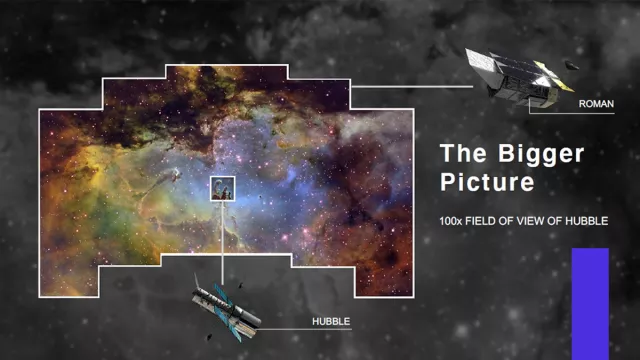Among the fleet of telescopes designed to observe and gain new insights into the universe, the future Nancy Grace Roman Space Telescope developed by NASA is set to drive major advances in cosmology and planetology, leveraging new technologies to deliver performance far superior to current space telescopes. In particular, its Wide Field Instrument will cover an area 100 times larger than Hubble, with comparable precision, while its high-contrast coronagraph will enable direct detection of planets never seen before by telescopes.
Key information
| Mission | Study dark energy and exoplanets |
|---|---|
| Domain | Universe science |
| Launch date | 2027 |
| Partners | NASA |
| Where | L2 Lagrange point (Earth-Sun) |
| Lifetime | 5 years with option for extension at end of primary mission |
| Status | In development (phase D: fabrication of flight models) |
Key figures
- 2.4-m-diameter mirror
- 0.5-to-2-um wavelengths, spanning visible to near-infrared
- 2,191 kg: satellite mass
- 2 instruments
Key milestones
- 2027: Scheduled launch of Nancy Grace Roman by Falcon Heavy
- 2024: Delivery of CGI and WFI instruments to GSFC for integration with satellite
- 29 September 2021: Critical Design Review
- 20 May 2020: WFIRST renamed Nancy Grace Roman by NASA
- 30 November 2018: NASA selects Harris Corporation to build telescope optics
- 17 February 2016: NASA approves WFIRST project
- 2010: NASA recommends WFIRST project
Project in brief
While the famous Hubble Space Telescope is entering its fourth—and probably final—decade in operation, several new space telescopes are lining up to take over its mantle. The Nancy Grace Roman Space Telescope—formerly the Wide Field Infrared Survey Telescope (WFIRST)—matches its illustrious predecessor in many ways. The most important similarity is its 2.4-metre-diameter primary mirror, just like Hubble’s. It will therefore offer much the same light-collecting power, but it outclasses Hubble with a field of view spanning an area of sky 100 times larger.
While the image resolution will be pretty much the same as Hubble’s, this vast field of view will enable millions of galaxies to be observed where Hubble could only see a few thousand. The Roman Space Telescope is thus primed to accomplish one of its main science goals, which is to deliver new insights into the mysterious “dark energy” making up 75% of all matter in the universe and driving its accelerating expansion. To do that, it will need to very precisely measure this expansion rate at different epochs, by observing it from different distances.
Another of the telescope’s key missions will be to survey exoplanets by direct detection, using a high-contrast coronagraph to mask the glare of their stars, and by studying the gravitational microlensing effects these planetary systems exert on images of distant stars. It is thus expected that more than 70,000 exoplanets could be detected, compared to the 6,000 currently known. The Roman Space Telescope will operate in the near-infrared, complementing telescopes operating in other wavelengths, such as Hubble viewing out to the ultraviolet and the James Webb Space Telescope (JWST) to the far-infrared.
CNES’s role
NASA asked CNES to join this mission and France is among the select number of partner nations. The agency is partnering with the LAM astrophysics laboratory in Marseille, which is supplying certain mirrors for the coronagraph and contributing its expertise acquired on Europe’s Euclid space telescope to develop building blocks for processing data from the telescope’s Wide Field Instrument (WFI). CNES is overseeing France’s contribution, providing funding, coordinating activities and offering its technical expertise where required.
Contacts
Project Leader
Pascale Danto
E-mail: pascale.danto at cnes.fr
Astronomy & Astrophysics subject matter expert
Philippe Laudet
E-mail: philippe.laudet at cnes.fr


